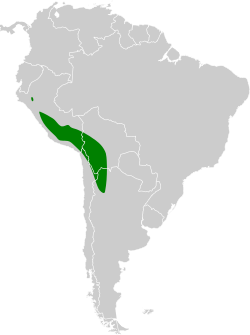| Puna teal | |
|---|---|
 | |
| A puna teal at Sylvan Heights Waterfowl Park in Scotland Neck, North Carolina. | |
| Scientific classification | |
| Kingdom: | Animalia |
| Phylum: | Chordata |
| Class: | Aves |
| Order: | Anseriformes |
| Family: | Anatidae |
| Genus: | Spatula |
| Species: | S. puna |
| Binomial name | |
| Spatula puna (Tschudi, 1844) | |
 | |
| Synonyms | |
Anas versicolor puna | |
The Puna teal (Spatula puna) is a species of dabbling duck in the family Anatidae. It was at one time regarded as a subspecies of the Silver teal (Spatula versicolor).
Contents
- Taxonomy
- Description
- Appearance
- Anatomy and Physiology
- Habitat and Distribution
- Behavior
- Diet and Feeding
- Mating and Reproduction
- Migration
- Vocalizations
- Relationship with Humans
- Conservation
- Population and Threats
- References
- External links
The Puna teal is resident in the Andes of Peru, western Bolivia, northern Chile, and extreme northwestern Argentina. [1] [2] It is found on the larger lakes and pools in the altiplano.
The status of the Puna teal is Least Concern, as listed on the IUCN Red List. [1]


